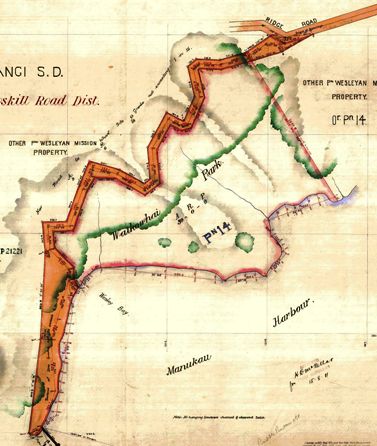Detail from SO 16220, 1911, LINZ crown copyright
Back in 1911, under a special act of Parliament which validated a previous agreement between the Wesleyan property trustees and the Mt Roskill Road Board, Waikowhai Park was passed to the Road Board's control. Later on, the Road Board evolved into a Borough Council, and amalgamated with Auckland City in 1989. But a rather pretty park has had a somewhat rocky history last century.
According to the text of the Waikowhai Park Act, the land was part of a vast area granted in 1850 to the Superintendent of the Wesleyan Mission in New Zealand "to hold unto the said Superintendent and his successors in trust, nevertheless, and for the use and towards the support and maintenance of the school therein recited as established at Three Kings ..."
"The native teachers of the Karakariki school, on the Waipa (Andrew and Martha Barton) deserve my praise, and the favourable consideration of Government, for their exemplary conduct, and for their untiring and really valuable services in the work of education." In the same year that the removal to the Three Kings had been carried into effect Governor Grey supplemented the gift of Governor Fitzroy by a grant of twenty acres near to the land already held in trust. In the deed of conveyance of this land the European element is first introduced. The deed states that the land is given in support of "the education of our subjects of both races, and of children of poor and destitute persons being inhabitants of the islands of the Pacific Ocean; in trust, nevertheless, and for the use or towards the support and maintenance of the said school so long as religious education, industrial training and instruction in the English language shall be given to those educated therein or maintained thereat." Other grants of land made on similar terms to the institution have placed it in possession of about 600 acres. This includes a place called Waikowai, on the Manukau, deserted by the natives. The soil at the latter place is not considered very good but firewood can be obtained on the spot, and the Maoris connected with the institution have chosen the place near a fishing ground, and by this means succeed occasionally in procuring an agreeable change of food.
Otago Witness 20 August 1864
By the end of the 19th century, the area was becoming recognised as a recreation spot for those hardy travellers braving the rough-and-ready Ridge Road to enjoy a Manukau foreshore getaway from it all.
WHERE IS CAPE HORN?IT ADJOINS WAIKOWAI BAY AND WATTLE BAY, MANUKAU HARBOUR. Cape Horn is a Government Reserve, BEST PLACE FOR PICNIC PARTIES During the Summer Months. ~ Within 45 minutes drive of Auckland, and Half Mile past Klondyke Store, Mt. Roskill.
Auckland Star 12 December 1900
On 20 July 1911, the Wesleyan Trustees came to their agreement with the Road Board, but needed the power of an act of Parliament to reverse the earlier 1850 grant in this case.
Any scenic reserve runs a great risk of being destroyed by fire (says the "New Zealand Herald"), especially if holiday-makers are allowed to picnic in it. Waikowhai Park, which is shortly to be opened to the public, is no exception to the rule. Water has been laid on for the benefit of holiday makers, but it is not intended to allow visitors to light fires and thus jeopardise the safety of the reserve. The caretaker will see to the boiling of water for holiday makers, and no one else will be allowed to light a fire for any purpose whatever. By this means it is hoped to preserve what is one of Auckland's numerous beauty spots.
NZ Truth 17 January 1914
Sadly, though, the park was used as a landfill site during last century. There is still quite visible signs of leachate from the soils there, but rehabilitation work has been done and new concrete paths have been laid. In summer, a walk around the park, with its stunning views of the Manukau Harbour, would be well worth the trek.
It also has a set of ruins.
At some point, this was a changing shed block. Probably abandoned and left to rot when the park was just used as landfill, its age is uncertain.
Looks like where cubicles used to be, the partitions long gone.
But someone hanging around down in the damp and the weeds has added an interesting touch to the old remains -- a fireplace painted on the bare concrete wall, complete with comforting fire.






The fire is unconvincing. It still looks very cold.
ReplyDeleteIt is very cold. Which is why I was quite taken by the image. Someone refusing to accept the reality there.
ReplyDeleteGreat Post Lisa. I see what you mean by the Fire place painted there. It's not bad for a piece of urban art. Cold reality with the warmth of memory comes to mind.
ReplyDelete"Cold reality with the warmth of memory ..." I like that, Liz. Yes, that sums it up nicely. Cheers!
ReplyDeleteAny chance you can relay the location of the ruins?
ReplyDeleteThey aren't a secret -- just follow the paths, towards the coastline. They're just the remains of the changing block.
ReplyDelete